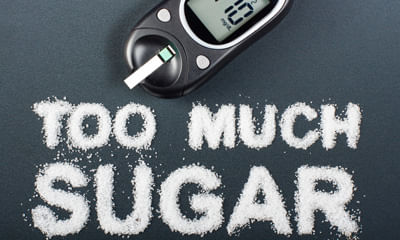Diabetes Mellitus
Diabetes mellitus is caused by a deficiency in the secretion of insulin.
Predisponsing factors:
the various predisposing factor are:
- heredity: a familial tendency to diabetes has been found to exist genetic factors are involved when the disease develops before the age of 40 years
- age: the disease occurs at all ages but a greater percentage of the cases occurs in persons over 45 of age.
- sex: the disease affects both sexes. the incidence of the disease is somewhat greater in men tha in women.
- obesity: the incidence of diabetes is greater among obese persons than in persons of normal weight.
- stress: stresses of various types,ex. frequent intections, worry irregular meals, etc. may also contribute to the development of the disease.
Metabolism in diabetes mellitus:
The metabolismof carbohydrates, fat and protein in diabetes mellitus is briefly discussed below:
- Carbohydrate metabolism: due to decreased oxidation of glucose in the tissues, the level of blood glucose is increased markedly, leading to glycosuria. the quantily of glucose present in urine may very from 0.5 to 6% depending on the severity of the disease. the volume of urine is increased (polyuria).
- Fat metabolism: since, glucose is not utilised, there is increased breakdown of fats to acetate and ketone bodies (acetoacetic acid, acetone and β-hydroxybutyric acid. the keto acidosis which develops may lead to dehydration and coma in severe diabetes. the serum cholesterol and triglyceride levels are high.
- Protein metabolism: since carbohydrates are not utilised for the production of energy, there is increased breakdown of tissue proteins and increased oxidation of dietary proteins for use as energy. hence, there is an increased in nitrogen excetion leading to negative nitrogen balance wasting of muscles is a common symptom in chronic diabetes. hence, diabetics need more proteins (about 2g/kg body weight) rgan normal subjects. the protein allowances should be corresponsingly higher (50% higher) for daibetic children and expectant and nursing mothers. further, increased protein intake may hepl to increase insulin production.
Clinical types of diabetes:
the classification of diabetes from the clinical point of view is as follows :
- juvenile daibetes
- adult diabetes
- juvenile daibetes: this includes all daibetics below the age of 20 years. the disease is primarily due to deficiency of insulin. the subjects are generally undernourished and ematiated. they require a high calories, high protein diet and insulin for maintaining the blood sugar level within normal limits.
- adult diabetes: (maturity onset diabetes) a majority of them are pbese subjects. the treatment will consist of a reducing diet rich in proteins and carbohydrates along with oral anti-diabetic drugs to maintain the blood glucose within normal limits. these subjects require less insulin than juvenile diabeyes.
Treatment of diabetes mellitus
the principles of treatment are as follows:
- diet
- moderate exercise
- insulin in juvenile daibetes and sever adult diabetes and/or oral anti-daibetic drugs in mild to moderate adult diabetes.
diet: only weighed quantitis of food should be consumed according to the diet schedule prescribed by the physician. the most important consideration should be given to:
- calories needs
- the proportion of calories from carbohydrate, fats and protein.
- calorie requirements: the calorie requirements should be about 5% less than the actual requirements for the patient’s height and ideal body weight.
THE PROPORTION OF PROTEIN, FAT AND CARBOHYDRATE IN THE DIET:
the proportion of calories derived from carbohydrates, fats and proteins in the diet will depend on the type of diabetes as indicted below in table:
|
type of diabetes |
carbohydrates |
fats calories (%) |
proteins |
|
|
juvenile diabetes |
40 |
40 |
20 |
|
|
adult obese diabetics |
60 |
20 |
20 |
|
|
adult diabetics with normal body weight |
40 |
40 |
20 |
|
proteins: since, diabetics in general are in negative nitrogen balance, they should receive about twice as much proteins as normal subjects. the proteins should be of high biological value and provide about 20 to 25% of the calories in the diet.
fluid: a liberal intake is desirable.
carbohydrates: the daily intake of carbohydrates should provide about 40% of the calories to prevent ketosis. the carbohydrate intake should not exceed 40% of the total calorie intake (except in the case of obese diabetics as indicated in above table) as otherwise it will be difficult to control the blood sugar level.



+1.svg)
